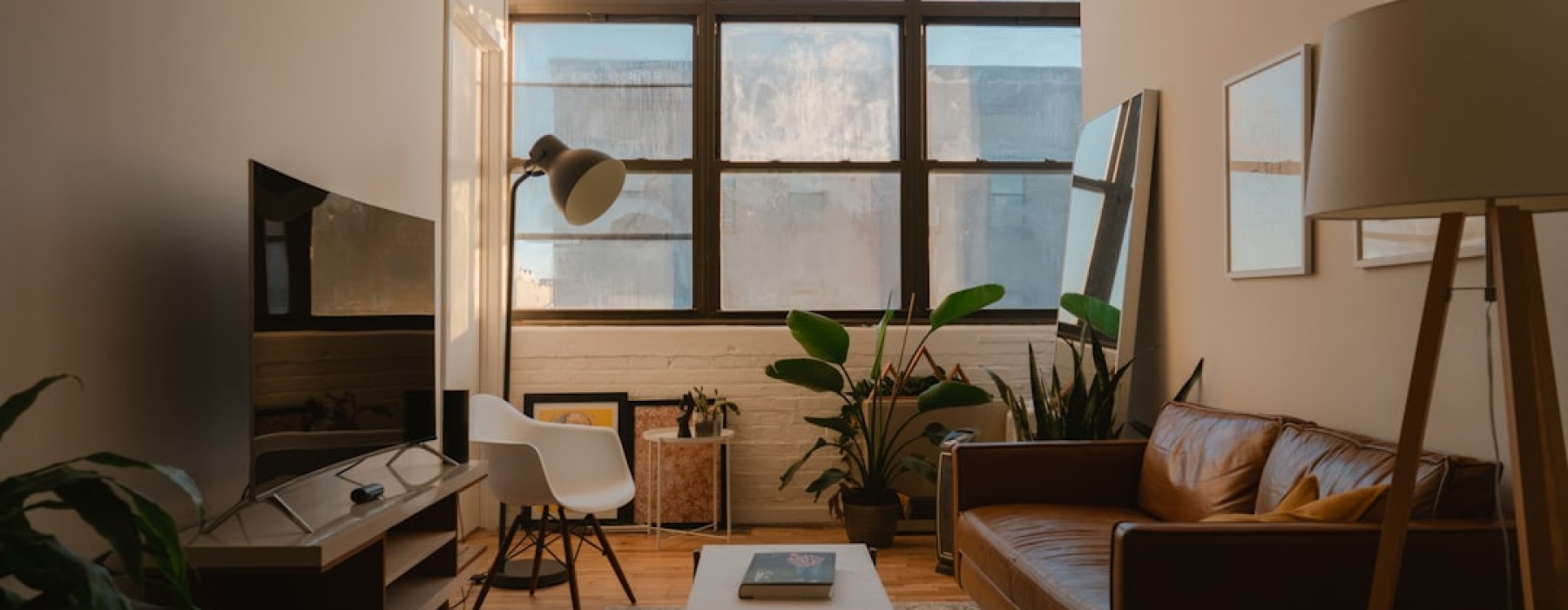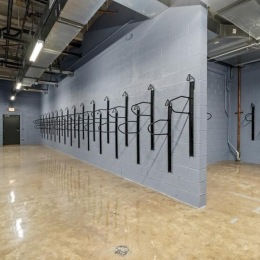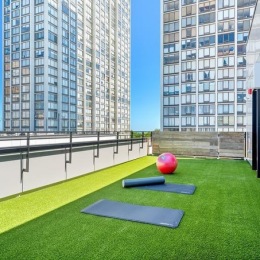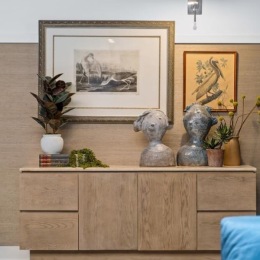Why Studio Apartment Change Is the Ultimate Design Challenge
A studio apartment change turns your single-room space into a masterclass of efficiency and style. Research from Houzz shows that well-organized small spaces consistently outperform larger homes in both livability and long-term satisfaction, while Google and Pinterest report climbing searches for studio design ideas throughout 2024.
Key Studio Change Strategies:
- Strategic Zoning - Create distinct living areas without walls using furniture, rugs, and lighting
- Smart Storage - Maximize vertical space with floating shelves, under-bed bins, and multi-functional pieces
- Layered Lighting - Combine ambient, task, and accent lighting to expand perceived space
- Intentional Color - Use light palettes and mirrors to brighten and visually enlarge your home
- Multi-Functional Furniture - Choose pieces that serve multiple purposes like storage ottomans and wall-mounted desks
"You walk in, and that's it—bedroom, kitchen, and living room all sharing the same square footage, no doors to shut or walls to divide. It's not just a layout; it's a design puzzle. And when done right, it can be a masterclass in efficiency and style."
Your studio apartment is essentially a blank canvas. The key is understanding that thoughtful design, not square footage, is what people remember and value in a home. Every design decision in a studio has a compounded spatial and psychological impact, making intentional choices more critical than ever.
Living in a studio doesn't mean sacrificing style or comfort. With the right strategies, you can create distinct zones for sleeping, working, and entertaining while maintaining the open, airy feel that makes small spaces special.
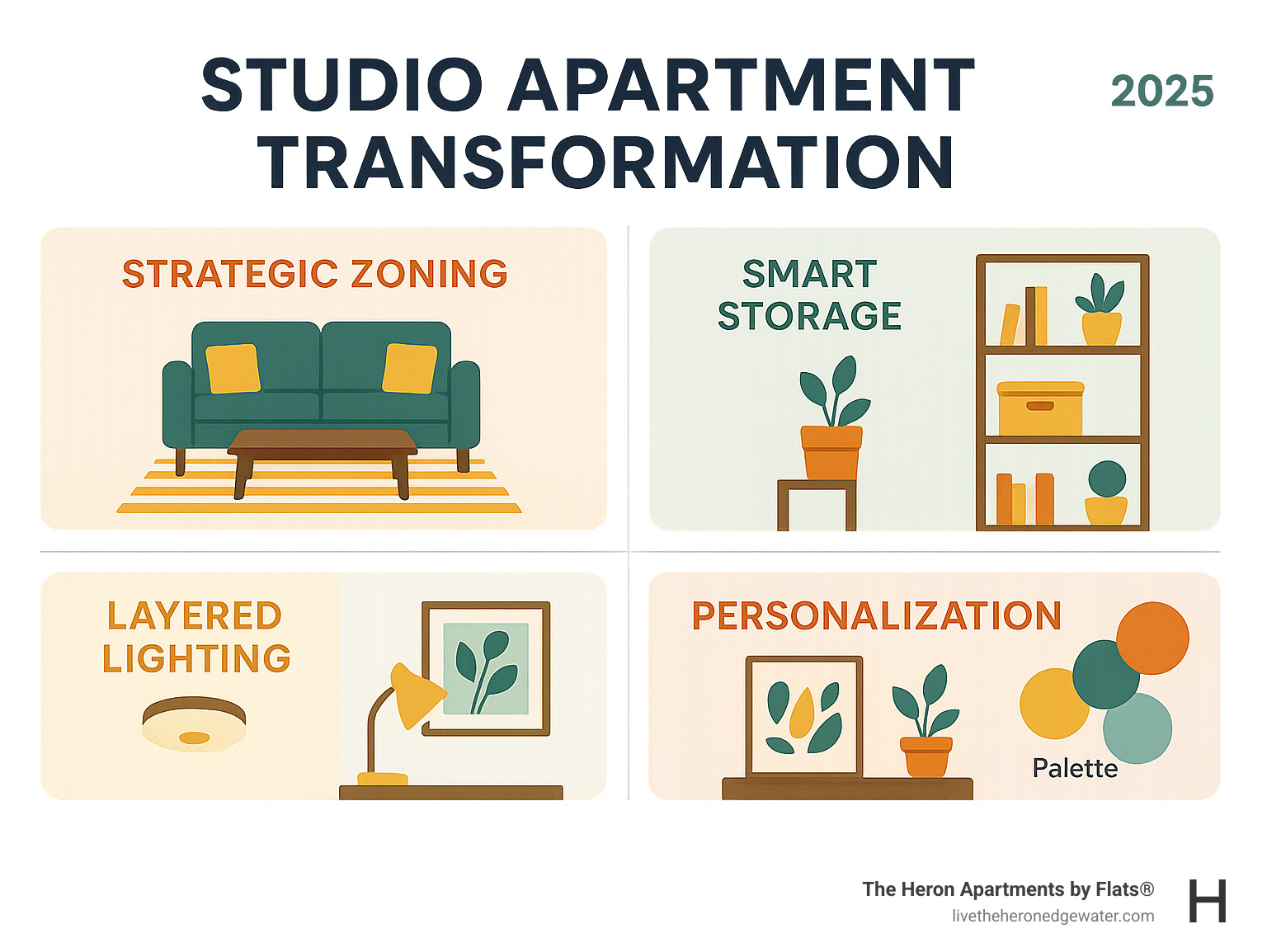
The Foundation: Maximizing Space and Functionality
When we approach a studio apartment change, our primary goal is to make every square inch count. This isn't just about fitting things in; it's about making the space work smarter, creating a feeling of spaciousness and purpose within a single room. The success of a small space hinges on ingenious design that prioritizes both functionality and visual appeal.
One of the most effective ways to achieve this is by embracing the full potential of vertical space. Instead of letting walls sit empty, we can use them for storage and display, drawing the eye upward and creating a sense of height. This could involve tall bookshelves that reach the ceiling, wall-mounted shelving units, or even hanging organizers. For instance, instead of just art, walls can be used for storage, especially when floor space is limited.
Another crucial element is the strategic placement of furniture. In a studio, traditional layouts often don't work. We might need to consider unconventional arrangements, such as floating a bed with a dresser behind it to segment the space, or placing a daybed to serve as both a sleeping area and a sofa. "How you set out your furniture in a studio apartment idea can make or break the space." This requires careful measurement of your studio to ensure every piece fits perfectly and serves its intended purpose, often more than one.
For example, a 400-square-foot Denver studio apartment was transformed by intentionally moving the bed closer to the window, opening up the main living area. This simple shift, along with the strategic use of a wall system that doubled as a TV stand, bar, kitchen storage, and dresser, made the space feel significantly larger and more functional. We understand that in a studio apartment, each piece of furniture should serve its purpose, and often, that purpose is dual or even triple.
When considering what to bring into your studio, measuring everything is key. This helps ensure that every item has a designated place and contributes to the overall efficiency. For those seeking luxury apartments in Edgewater, Chicago, we focus on designs that already maximize this potential, offering sophisticated solutions for compact living. Explore our studio apartments in Edgewater, Chicago
Creating Distinct Zones in a Single Space
The illusion of separate rooms within a studio apartment is a cornerstone of a successful studio apartment change. This is where "spatial legibility" comes into play – the ability of a space to clearly communicate its purpose through layout, materiality, and furniture placement. We achieve this not by building walls, but by using clever visual separation techniques.
Room dividers are a classic solution. These can range from standalone bookshelves that delineate a sleeping area from a living space, to neat glass dividers that offer separation without blocking light. Even strategic indoor plants can be used to subtly zone a space, adding life and a natural element.
Curtains offer a flexible and often renter-friendly way to create privacy or define zones. Floor-to-ceiling curtains, for example, can be pulled across a bed area to create a private sleeping nook, or used to filter light and provide privacy in lieu of solid walls. One creative change even involved converting an existing closet into a bed alcove, with half-height louvers and curtains providing a balance of enclosure and visibility.
Area rugs are another powerful tool for zoning. Simply by placing a different rug in each functional area – one under your bed, another in your living space – you can visually create distinct "rooms." Furniture grouping also plays a vital role; arranging your sofa and chairs around a coffee table instantly defines a living zone. For example, a 330-square-foot apartment used a loft add-on to create separate zones for working, sleeping, and living. The art of visual zoning is extremely helpful for spatial legibility in small-space living.
We believe in innovative solutions that adapt to your needs. This is why we are excited to offer apartments with adaptable Ori units, which truly redefine how distinct living zones can be created within a single studio space. See how Ori systems transform your space
The Power of Multi-Functional Furniture
In the field of studio apartment change, multi-functional furniture is not just a convenience; it's a necessity. Modern furniture design makes it easy to mix function with aesthetics, ensuring that every piece serves a dual, if not triple, purpose. This approach is fundamental to maximizing space and maintaining a clutter-free environment.
Consider sofa beds, for instance. They offer comfortable seating by day and a sleeping solution for guests (or yourself) by night. Lift-top coffee tables provide a surface for drinks and snacks, but can also transform into a dining table or a workstation, often with hidden storage inside. Foldaway dining options, like wall-mounted desks that convert into dining tables or nesting tables that can be pulled out for extra surface area, are perfect for entertaining without committing valuable floor space permanently.
Ottomans with storage are another brilliant example. They can serve as extra seating, a footrest, or even a makeshift coffee table, all while discreetly hiding blankets, books, or seasonal clothing. A vintage cabinet, for example, can serve as both shoe storage and a bar, perfectly illustrating the concept of extreme multifunctionality.
We prioritize these types of pieces in our luxury apartments in Edgewater, Chicago, understanding that they are crucial for comfortable studio living. Here is a list of essential multi-functional furniture pieces for a studio:
- Sofa Beds/Daybeds: Offer seating and sleeping in one unit.
- Lift-Top Coffee Tables: Provide a surface, dining/work space, and hidden storage.
- Nesting Tables: Expandable surfaces that can be tucked away when not needed.
- Storage Ottomans: Serve as seating, footrests, and hidden storage.
- Wall-Mounted Desks: Foldable or slim desks that save floor space.
- Platform Beds with Drawers: Maximize under-bed storage without needing extra bins.
- Modular Shelving Units: Can be reconfigured to suit different needs and spaces.
- Bookshelves with Integrated Desks: Combine storage with a workspace.
- Bar Top Tables: A compact alternative to a traditional dining table.
- Entryway Benches with Storage: Provide seating for putting on shoes and hide clutter.
By carefully selecting and arranging these pieces, we can ensure that your studio apartment feels spacious, organized, and perfectly custom to your lifestyle.
The Art of Illusion: A Complete Studio Apartment Change
The magic of a successful studio apartment change lies in our ability to manipulate perception. We aim to make a small space feel significantly larger, brighter, and more inviting than its actual square footage might suggest. This isn't about trickery; it's about applying fundamental design principles that influence how we experience a room. Research in environmental psychology has shown that perceived spaciousness is influenced more by layout, lighting, and visual continuity than by actual square footage.
One of the most powerful tools in our design arsenal is the strategic use of color. Light colors, particularly on walls and ceilings, reflect light, making a room feel open and airy. But it's not just about color; it's about how light interacts with surfaces. The choice of materials, from reflective surfaces to high-quality textiles, also plays a significant role in creating an expansive feel.
For instance, a 193-square-foot Parisian studio apartment was transformed using sunlight, rich colors, and geometric forms to make it feel fresh, chic, and much larger. Similarly, a 538-square-foot art studio in Paris was converted into a bright and open small home using a minimalist aesthetic and a consistent white and light wood color palette. These examples highlight that even in the smallest of footprints, clever design can make a profound difference.
We believe that tight constraints demand more intentional design, where function and beauty are not mutually exclusive. The objective is to create a space that feels like a warm hug, not a sterile box, where space to breathe is the ultimate luxury. See inspiring changes
How Color and Light Brighten Your Home
Color has the power to unify your space and improve its design, and in a studio apartment, its impact is magnified. When planning a studio apartment change, we often recommend a light color palette as a foundational step. White paint, for example, is a classic choice for making spaces feel larger and brighter, as demonstrated in an Atlanta apartment where white paint and light floors significantly brightened the space.
However, a light palette doesn't have to be boring. We can achieve sophistication through monochromatic schemes, sticking to 2-3 base colors and 1-2 accent tones throughout your space. Tonal layering, using different shades of the same color, adds depth and richness without overwhelming the room. For those who dare, strategic accent walls with a darker hue, like the "dark and moody kitchen" created in a 475-square-foot studio, can effectively hide imperfections and create a distinct zone.
Lighting sets the tone and defines the elegance of a place. In low-light conditions, such as basement studios, strategic lighting is paramount. We advise incorporating at least three types of light:
- Ambient lighting: The general illumination of the room, often from ceiling fixtures.
- Task lighting: Focused light for specific activities, like reading lamps or under-cabinet lights in the kitchen.
- Accent lighting: Used to highlight features, such as artwork or architectural details, adding warmth and dimension.
Dimmers and smart bulbs with color temperature control offer flexibility, allowing you to adjust the ambiance from bright and energetic to warm and cozy. Human perception of comfort increases with layered, indirect lighting.
Mirrors are a tried and tested trick to expand small spaces. Placing large ornamental mirrors or smaller mirrors near windows and light sources can significantly brighten a room by reflecting natural and artificial light. Mirrored furniture can also subtly trick the eye into perceiving more space. For instance, nightstands with chrome legs can create a floating effect, adding to the illusion of openness. Wall-mounting lighting fixtures, like sconces, also frees up valuable floor space that floor lamps would occupy, minimizing clutter and enhancing the sense of openness.
A Guide to Your Studio Apartment Change with Texture and Personalization
While color and light define the boundaries of your studio, texture and personalization infuse it with warmth, character, and a sense of "home." In neuroscience-backed studies of residential design, texture has been shown to affect perceived warmth and visual complexity, making it a critical element in any successful studio apartment change.
When we talk about incorporating texture, we mean engaging the sense of touch and sight through various materials. Imagine the softness of a sheepskin rug, the crispness of linen curtains, the warmth of distressed wood furniture, or the cool, sleek feel of metal accents. A mix of materials like soft area rugs, velvet pillows, and oversized knit blankets can make a minimalist, all-white space feel incredibly inviting. Even playing with matte and glossy finishes can add subtle textural interest.
Personalization is essential to create a place that feels sophisticated and alive. This is where your studio truly becomes yours. We encourage you to choose artwork that reflects your style, display neat frames with cherished photos, and incorporate ceramic accents or curated coffee table books. Mixing high art with sentimental mementos creates a rich, layered aesthetic. "A well-decorated studio is cohesive, layered, and emotionally resonant without crowding the room or sacrificing daily function."
Adding plants, or "green areas," is another way to introduce life and improve air quality. Low-maintenance indoor plants like snake plants, peace lilies, or rubber plants placed in neat planters can bring a touch of nature indoors, creating varied heights and textures.
Finally, consider the power of scent. Studies show that scent triggers emotional associations faster than any other sense. Creating a signature scent for your home with candles, diffusers, or incense can reinforce a sense of comfort and belonging, making your studio feel even more personal and inviting. This holistic approach ensures that your studio is not just aesthetically pleasing, but also deeply comfortable and reflective of who you are. View our apartment gallery for inspiration
Overcoming Common Studio Challenges with Smart Design
Living in a studio apartment can feel like a puzzle, but with a little creativity and smart design, those challenges become exciting opportunities! The most common worries we hear are about finding enough storage, keeping clutter at bay, feeling private, and even having friends over. But don't worry, a thoughtful studio apartment change can easily solve all these.
Clutter, for example, isn't just messy; it can actually make us feel more stressed. That's why keeping things neat and organized is so important. Every item in your studio should have a special spot, easy to reach but tucked away when not in use.
And entertaining? It might seem impossible in a small space, but it's absolutely doable! We've seen people host lively dinners for ten and parties for up to twenty-four in a 500-square-foot studio, simply by being clever with their furniture. The trick is to have pieces that can adapt, like multi-purpose, folding, or expandable furniture. A small bar top table, for instance, might be perfect for daily use but can also serve guests when needed.
Privacy is another big one in an open studio. Since we can't just build new walls, we focus on smart visual and functional ways to create separation. We'll show you some easy, non-permanent ideas to define distinct areas for sleeping, working, and relaxing.
Here’s a quick look at how different solutions can help you make the most of your studio:
| Feature | Physical Dividers (e.g., Bookshelves, Screens) | Visual Zoning Techniques (e.g., Rugs, Lighting) |
|---|---|---|
| Privacy | High (can block sightlines) | Low to Medium (suggests separation) |
| Light Flow | Can obstruct | Maintains |
| Flexibility | Low (less easily moved) | High (easily changed or adjusted) |
| Installation | Can be complex | Simple |
| Sense of Space | Can reduce perceived size | Improves perceived openness |
| Acoustics | Minimal dampening | None |
Smart Storage Solutions for a Clutter-Free Life
The quest for a clutter-free home is extra important in a studio apartment. It’s a key part of any successful studio apartment change. Our golden rule is simple: "Curate, Don't Crowd." Every single item you own should be chosen on purpose, and it needs a home.
One of the best ways to make the most of your space is to look up! Think vertical. This means using tall bookshelves, wall-mounted cabinets, and floating shelves that reach high. Imagine a little nook in an apartment, transformed with a wall-to-wall dresser that fits perfectly. You can also add low-profile shelving on walls for your personal treasures and art.
Don't forget the space under your bed! It's a storage goldmine. Platform beds with built-in drawers or beds tall enough for rolling bins are game-changers for stashing away seasonal clothes. And ottomans with hidden storage are fantastic; they can be extra seating or a footrest, all while discreetly holding blankets or books.
Many studio dwellers have finded how versatile IKEA Trones shoe storage cabinets are. They're not just for shoes! You can use them for everything from socks to bathroom supplies, hats, scarves, or even tote bags. It's all about thinking outside the box!
Smart storage even extends to your kitchen. Stackable containers, magnetic knife strips, and slim pull-out organizers can make a small kitchen surprisingly efficient. Even a non-working fireplace can become a creative storage spot, perhaps for a few bottles of wine. The main goal is to reduce visual "noise" – too much visible clutter takes away from both comfort and a feeling of luxury. This thoughtful approach keeps your studio tidy and super functional, making it a true peaceful retreat. A deep dive into compact living trends
Your Guide to a Successful Studio Apartment Change
Beyond just storage, a successful studio apartment change means tackling the little things that make daily life better, especially privacy and having dedicated spots for different activities. Even though a studio is open, we can use clever tricks to create distinct areas without any big construction.
Creating privacy nooks is super important, especially for your sleeping area. Curtains or freestanding screens are perfect non-permanent solutions for renters. You can pull them around your bed to create the feeling of a separate bedroom, giving you a cozy, private space. Think of how area rugs can visually define "rooms" within an open space, even making a sleeping area feel separate.
If you need a home office, a wall-mounted desk or a foldaway option can give you a dedicated workspace without taking up precious floor space all the time. This helps you keep work and relaxation separate, which is extra important when your bed is just a few steps away.
At The Heron Apartments, we love designs that are easily adaptable. Our unique Ori units, for example, can transform your space with just a touch. Imagine your bed disappearing to reveal a living area, or a closet expanding for more storage. This kind of adaptable furniture is truly the future of modern studio living.
For renters, finding flexible solutions is key. You can use tension rod curtains for instant privacy around your bed, or freestanding room dividers that you can move whenever you like. Removable wallpaper lets you add a splash of color without damaging the walls, and peel-and-stick floor tiles or backsplashes offer easy cosmetic updates. Command Hooks/Strips are perfect for hanging art without drilling, and smart lighting solutions along with furniture on wheels give you the freedom to easily change your space for entertaining or different activities.
These smart solutions let you create a dynamic living experience, allowing your studio apartment to change with your needs and preferences, all without any permanent alterations. Explore apartments with Ori units that redefine studio living
Conclusion
A studio apartment change is much more than just a fresh coat of paint. It's about looking at a smaller space and seeing endless possibilities. We've explored together how smart design can turn any challenge into a chance to be creative. From using every inch of vertical space to choosing furniture that does double duty, and even using light and color to make a room feel bigger, every choice helps create a home that feels grander, brighter, and works better for you.
The key ideas we've shared – like strategic zoning, smart storage, layered lighting, and intentional personalization – are not just trendy ideas. They are the building blocks for a comfortable and happy studio life. Think about it: a well-organized small space truly leads to a more enjoyable home, as studies show.
Your studio isn't just four walls; it's your personal canvas. Every item you choose, every corner you design, tells your story and serves a purpose. Small spaces truly shine when they are designed with care. They don't have room for clutter or rushed decisions. Instead, they ask for thoughtful choices and reward you with clever solutions.
At The Heron Apartments, we accept these very ideas. We offer luxury apartments in Edgewater, Chicago, designed with your needs in mind. We understand what makes studio living special. That's why our homes come with modern features to make your life easier and more enjoyable. With unique options like adaptable Ori units, we are changing how studio apartments can work for you. Imagine changing your space with just the touch of a button! Plus, your furry friends will feel right at home too, with our pet-friendly facilities.
Are you ready to change how you live? Find how smart planning and clever design can create a beautiful home that fits your lifestyle perfectly. Explore apartments with Ori units that redefine studio living
